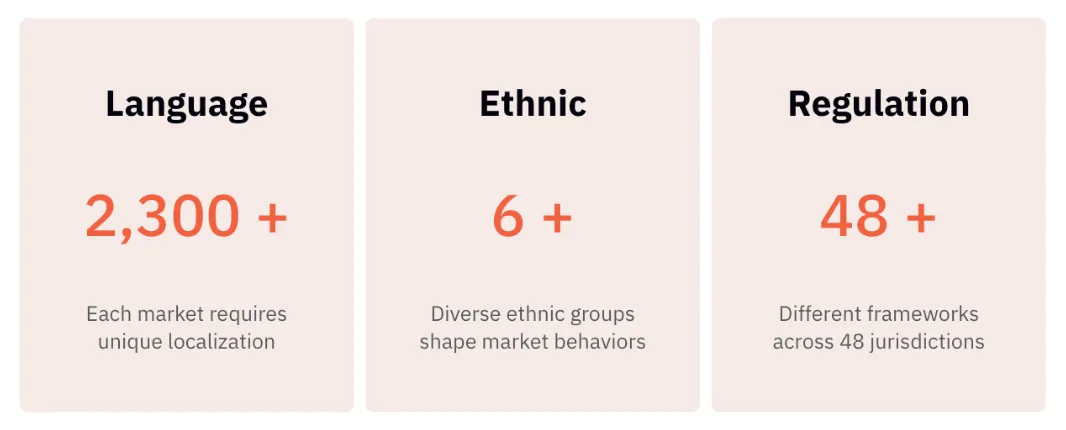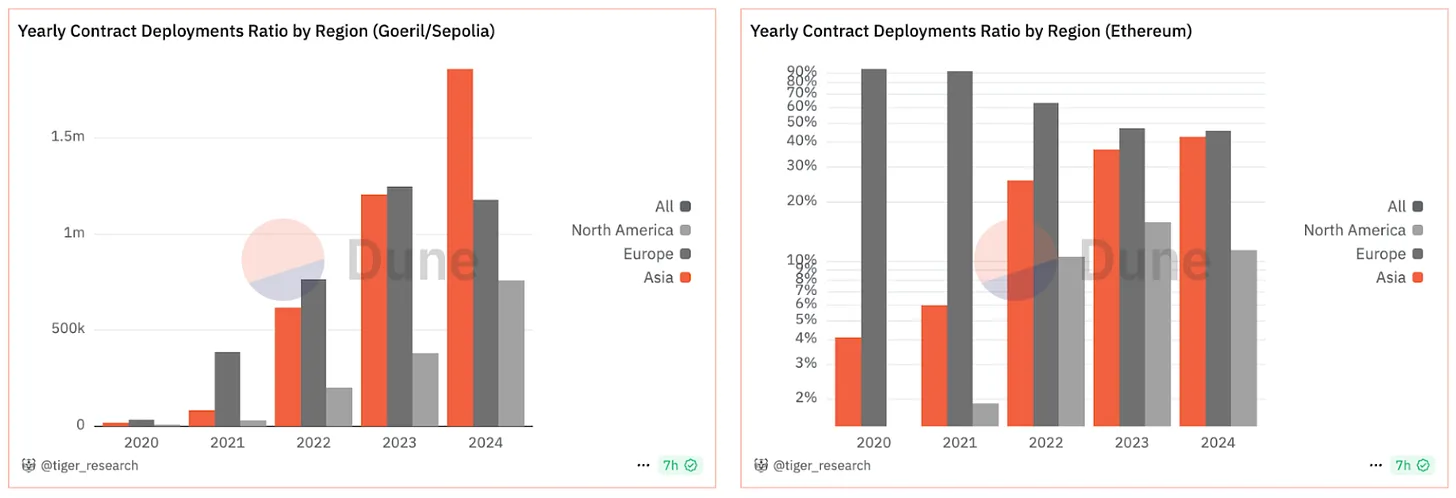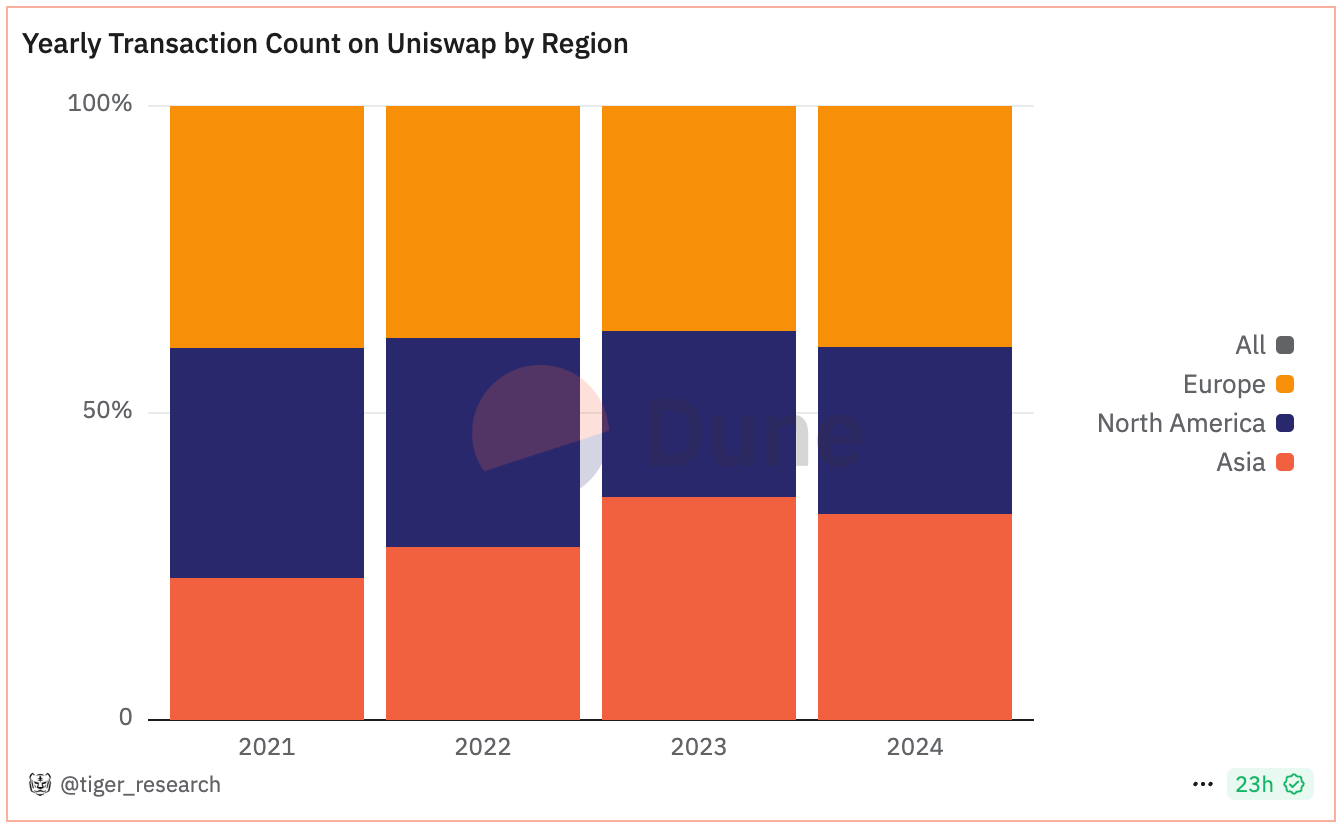On-chain data indicates that the Web3 market in Asia is growing.
Author: Tiger Research Reports
Compiled by: Deep Tide TechFlow
Key Takeaways:
The Asian market is complex and diverse, with varying regulations and cultures. Understanding the characteristics of each country is key to participating in the Web3 industry.
Asia has a large population of young digital natives, giving it significant leading potential in the Web3 market, especially in super apps and consumer applications.
On-chain data shows that the Web3 market in Asia is growing, with relevant indicators including stablecoin usage, developer activity, trading volume on decentralized exchanges, and engagement on Web3 social media.
1. Diversity and Complexity of the Asian Market

To understand the Asian market, one must recognize its diversity and complexity. Asia has over 2,300 languages and is divided into different regions such as Northeast Asia, Southeast Asia, Southwest Asia, and South Asia, with more than 48 different regulatory frameworks. The cultural differences within Asia are often greater than those between Western countries.
This diversity also impacts the Web3 industry in Asia. In Northeast Asia, each country has its unique approach: China implements strict regulations, South Korea combines regulation with incubation, and Japan supports Web3 through government policies. This unique combination in Asia requires specific strategies and in-depth understanding to succeed in the market.
2. Strong Growth Foundations in Asia
Despite the challenges posed by diversity, Asia's importance cannot be overlooked. Asia is home to over 60% of the world's population, contributing 34% of global GDP, with a growth rate of 3.6% that surpasses North America and Europe.

Asia is leading in the Web3 industry for three main reasons. First, Asia has a large cryptocurrency user base, with 60% of global crypto users, or 320 million people, coming from this region, thanks to a significant number of young digital natives (Triple-A). Second, trading activity in Asia is very active: by early 2024, the trading volume in South Korean won exceeded that of the US dollar, and recently, over half of Binance's web traffic came from Asia. Finally, Asia has a strong talent pool, with 50 million GitHub developers and 40% of global Web3 game developers.
3. Advantages of the Asian Web3 Market: Consumer Orientation and Super Apps
To popularize the Web3 industry, consumer applications that are easy for the general public to use must be developed. Simply building the technological infrastructure is not enough. This is similar to the early development of the internet, where "killer apps" like email drove rapid adoption. Similarly, Web3 is expected to gain widespread popularity through consumer applications that can seamlessly integrate into people's daily lives.

Asia stands out in two aspects. First, it is at the forefront of consumer-oriented innovation. As of October 2024, 42% of unicorn companies in Asia are B2C companies, a higher proportion than in North America and Europe. This advantage stems from Asia's large population of digital natives and advanced mobile payment systems. A consumer-centric approach positions Asia as a potential hub for emerging Web3 applications.

Asia's second advantage lies in its unique super app ecosystem. Leading platforms like WeChat, Alipay, Kakao, Line, and Grab, which initially offered single-service applications, have now evolved into comprehensive digital ecosystems. These super apps have become part of the daily lives of millions of users, providing services across payments, commerce, entertainment, and more.
The TON blockchain demonstrates the potential of combining Web3 with super apps. By adding Web3 features to the popular messaging app Telegram, there has been a surge in user numbers due to its convenience. These examples illustrate how super apps can effectively lower the barriers to entry for Web3. This combination will introduce new services in familiar environments, promoting the adoption of Web3.
4. Data-Driven Analysis of the Asian Web3 Market
The Asian market shows strong potential. However, relying solely on expectations and indicators may be superficial. Analyzing on-chain data to understand real user activity is key to gaining deep insights.

Japan's stablecoin policy is constantly evolving, indicating the need for deeper analysis. Although stablecoin guidelines were released in June 2022 and legal revisions in 2023 allowed for the issuance of stablecoins, these policies have not had a significant impact on the blockchain. This is mainly due to the limited application scenarios for issuing trust-based stablecoins on public blockchains and regulatory hurdles. To bridge the gap between policy and actual application, more detailed on-chain analysis is needed.
Next, we will evaluate whether the anticipated growth in the Asian market is being realized through on-chain data analysis.
4.1. Stablecoins in Asia

The use of stablecoins in the Asian market is steadily increasing. This trend is significant because stablecoins are one of the products that best meet market demand in Web3. On-chain data shows that stablecoin trading volume in Asia has surged to nearly $8 billion and is expected to continue growing from 2022 to 2024.
Stablecoins pegged to national fiat currencies are bringing more real-world application scenarios. For example, local currency-backed stablecoins like Singapore's XSGD and Indonesia's XIDR are on the rise. The integration of XSGD with services like Grab is driving its practical application. This localized approach and integration with real services are promoting an increase in stablecoin trading. Ongoing growth indicates that a structural transformation is occurring in the Asian market, rather than just a short-term phenomenon.
4.2. On-Chain Activity of Asian Developers
The participation of Asian developers in smart contract development is steadily increasing. This trend can be observed from on-chain data from the Ethereum mainnet and testnets (Goerli and Sepolia).

By 2024, Asian developers had created approximately 1.7 million contracts on these testnets, far exceeding the activity levels in North America and Europe. Since 2022, there has been rapid growth, with similar trends on the Ethereum mainnet. The share of contract creation in Asia has increased from 4% in 2020 to 40% in 2024.
This change highlights two trends: first, Asian developers are becoming a driving force for blockchain innovation; second, blockchain development is transcending its Western origins. High activity on testnets reflects positive experimentation, indicating that Asian developers are important contributors to the future of Web3.
4.3. Participation of Asian Retail Investors in Decentralized Exchange (DEX) Trading

Uniswap trading data shows strong participation from Asia. From 2021 to 2024, Asia consistently held a significant share of total trading volume. During this period, trading activity steadily increased.

In the Asian market, the participation rates of different types of investors are particularly noteworthy. We found significant changes when categorizing trading sizes into large investors (over $100,000), medium investors ($10,000 to $100,000), and small investors (less than $10,000). In 2021, shrimp-sized investors accounted for a small proportion of trading volume. However, by 2024, their share in both transaction count and volume has steadily increased. This change is a positive signal, indicating that users in the Asian market are increasingly utilizing Web3 services, being active not only in centralized exchanges (CEX) but also in decentralized exchanges (DEX).
4.4. Activity of Asian Users on the Web3 Social Network Farcaster

In the Web3 ecosystem, the activity of Asian users on Farcaster has drawn attention. Daily active user (DAU) analysis shows that Asian users are more active than users from North America and Europe. Although English is the primary language of Web3, posts in local languages such as Vietnamese, Chinese, Japanese, and Korean are steadily increasing. This indicates that the growth of Web3 in Asia has already begun, rather than being merely a prediction. Asia is leading in the use of Web3.
5. Conclusion
The Asian market is diverse, with unique regulations, cultural differences, and varying approaches among countries. This complexity presents both challenges and opportunities for Web3. Understanding the unique roles of each country is crucial. On-chain data reveals the potential of the Asian Web3 market by showcasing real user behavior.
Regional analysis based on on-chain data is crucial for the growth of the ecosystem. Advances in digital credentials and regional analysis will enhance the accuracy of user behavior insights. These tools help to gain a clearer understanding of the regional context and preferences of the Asian Web3 market.
Appendix. Research Methodology
Time-based analysis of blockchain transactions is a straightforward method that clearly segments data by the time of day. However, short-term data such as one-off transactions or irregular activities may not accurately reflect overall behavior patterns. To address this issue, we focus more on the long-term transaction patterns of wallets rather than the timing of individual transactions. Additionally, to ensure the reliability of the data, we need to exclude wallet addresses associated with sources that may affect data accuracy, such as automated bots, project teams, and exchanges. We used identification methods like Crypto Name Service (CNS) and credentials to distinguish between real users and bots. At the same time, we utilized tagged data from platforms like Dune Analytics to exclude project-related addresses. Work and sleep times are defined as follows:
United States: Work hours are from 8 AM to 8 PM ET (1:00 PM - 1:00 AM UTC), and sleep hours are from 12 AM to 6 AM ET (5:00 AM - 11:00 AM UTC)
Europe: Work hours are from 8 AM to 8 PM CET (7:00 AM - 7:00 PM UTC), and sleep hours are from 12 AM to 6 AM CET (11:00 PM - 5:00 AM UTC)
Asia: Work hours are from 8 AM to 8 PM CST (12:00 AM - 12:00 PM UTC), and sleep hours are from 12 AM to 6 AM CST (4:00 PM - 10:00 PM UTC)
In our geographic analysis, we focus on the patterns of active hours (8 AM to 8 PM) and sleep hours (12 AM to 6 AM), rather than just the time of day. If users have less activity in the late night hours in a region, they are more likely to be from that region. We assign a weight of 0.3 to active hours and 0.7 to sleep hours. Verified by partner network traffic data, this method has a fivefold lower error rate than simple transaction time analysis, with an average error of less than 2%. With the continuous development of authentication and digital credential services, we will be able to conduct more accurate regional analyses. This will become a key tool for analyzing the Web3 ecosystem, as understanding the local context and user behavior patterns is essential.
免责声明:本文章仅代表作者个人观点,不代表本平台的立场和观点。本文章仅供信息分享,不构成对任何人的任何投资建议。用户与作者之间的任何争议,与本平台无关。如网页中刊载的文章或图片涉及侵权,请提供相关的权利证明和身份证明发送邮件到support@aicoin.com,本平台相关工作人员将会进行核查。




